Organisational Behaviour Report: Cadbury's Culture and Motivation
VerifiedAdded on 2023/01/12
|18
|5837
|43
Report
AI Summary
This report provides a comprehensive analysis of organisational behaviour, focusing on the British multinational brand, Cadbury. It delves into the influence of organisational culture, power dynamics, and political landscapes on individual and team performance. The report explores various aspects of organisational culture, including power, role, task, and person cultures, and their impact on employee behaviour. It also examines the significance of organisational politics, differentiating between positive and negative forms and their consequences. Furthermore, the report evaluates different motivation theories, such as Maslow's hierarchy of needs, and their application in achieving organisational goals. It also discusses the characteristics of effective and ineffective teams, with an application of Tuckman's Model for team formation. Finally, the report includes an application of the path-goal theory to a relevant organisational scenario.
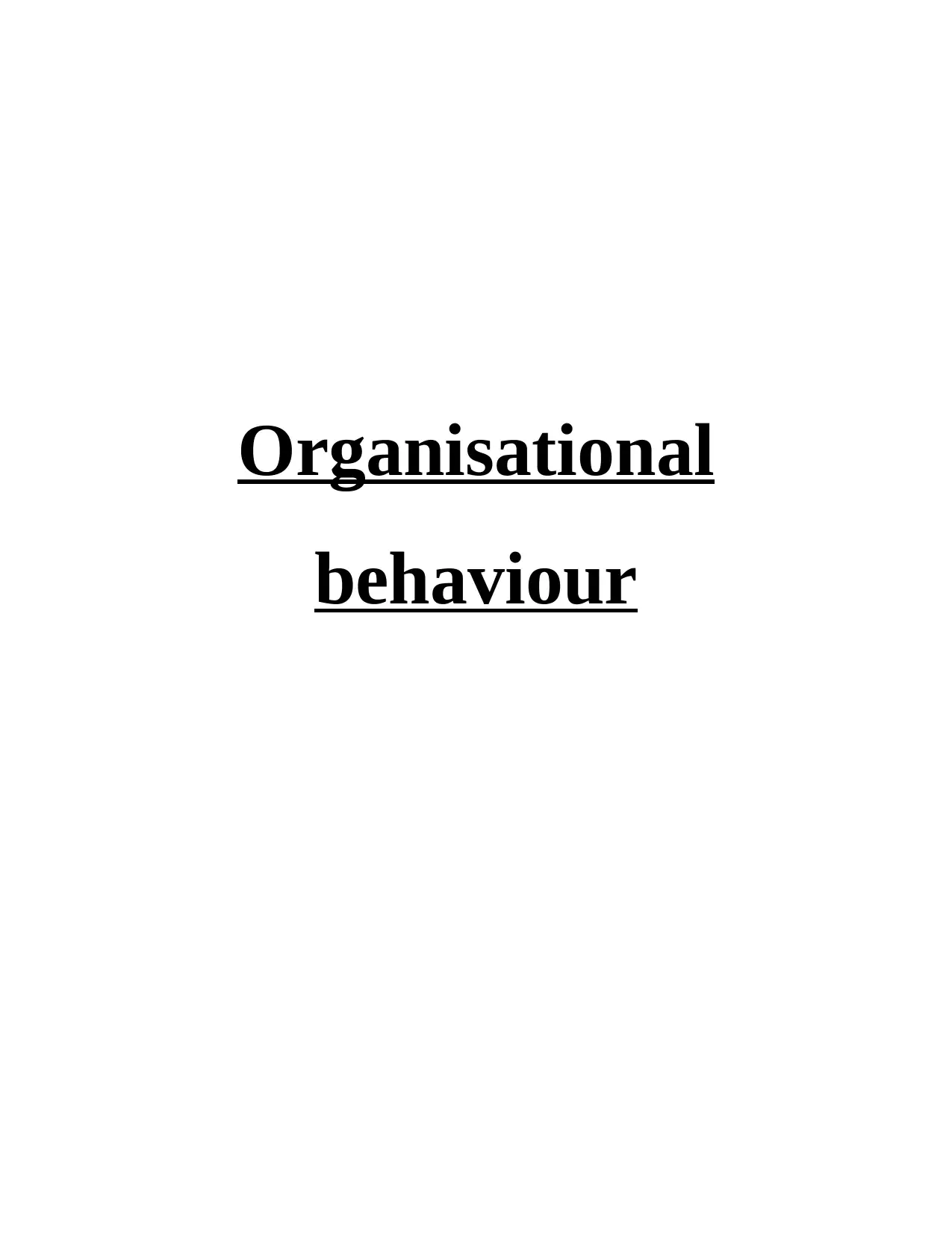
Organisational
behaviour
behaviour
Paraphrase This Document
Need a fresh take? Get an instant paraphrase of this document with our AI Paraphraser
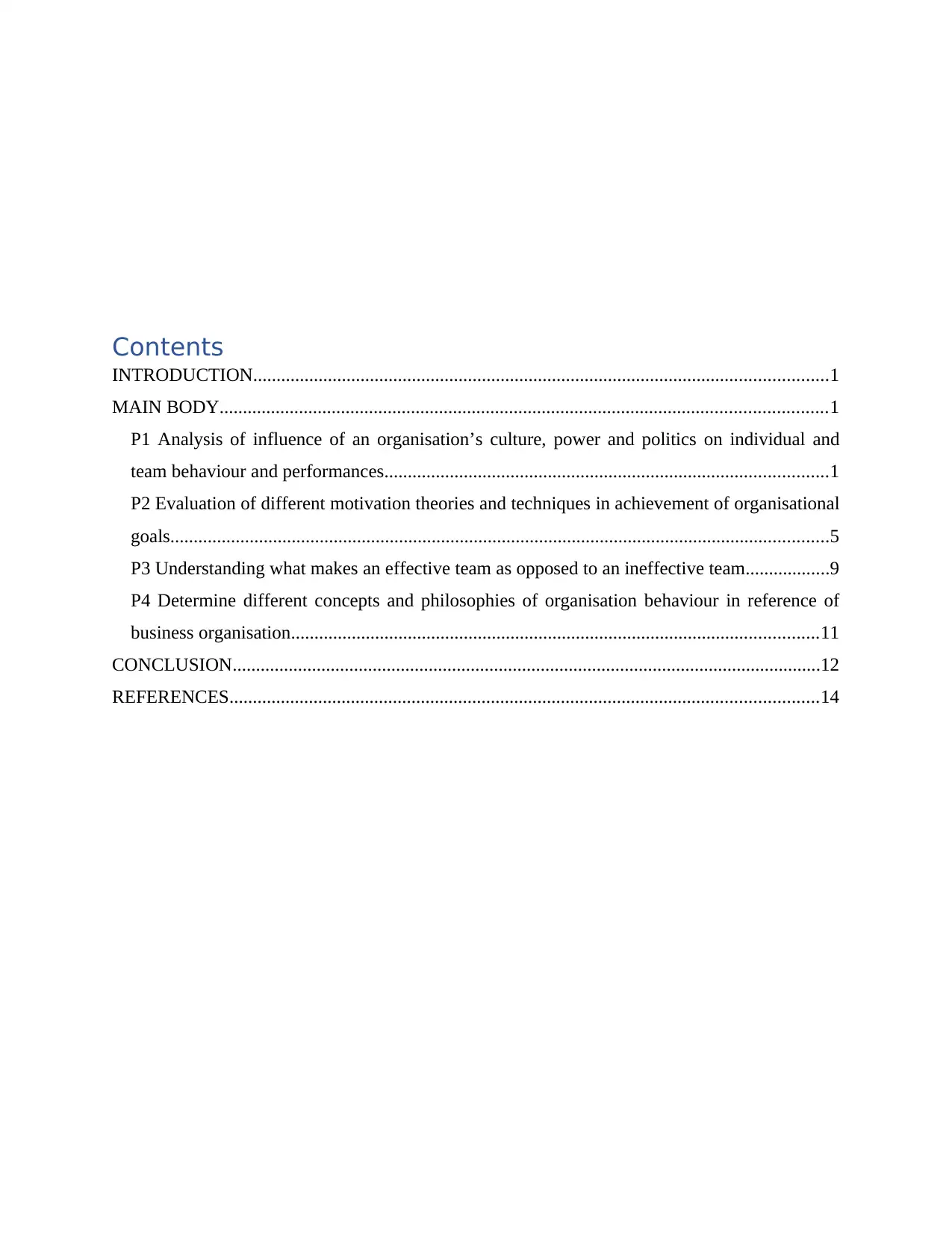
Contents
INTRODUCTION...........................................................................................................................1
MAIN BODY..................................................................................................................................1
P1 Analysis of influence of an organisation’s culture, power and politics on individual and
team behaviour and performances...............................................................................................1
P2 Evaluation of different motivation theories and techniques in achievement of organisational
goals.............................................................................................................................................5
P3 Understanding what makes an effective team as opposed to an ineffective team..................9
P4 Determine different concepts and philosophies of organisation behaviour in reference of
business organisation.................................................................................................................11
CONCLUSION..............................................................................................................................12
REFERENCES..............................................................................................................................14
INTRODUCTION...........................................................................................................................1
MAIN BODY..................................................................................................................................1
P1 Analysis of influence of an organisation’s culture, power and politics on individual and
team behaviour and performances...............................................................................................1
P2 Evaluation of different motivation theories and techniques in achievement of organisational
goals.............................................................................................................................................5
P3 Understanding what makes an effective team as opposed to an ineffective team..................9
P4 Determine different concepts and philosophies of organisation behaviour in reference of
business organisation.................................................................................................................11
CONCLUSION..............................................................................................................................12
REFERENCES..............................................................................................................................14
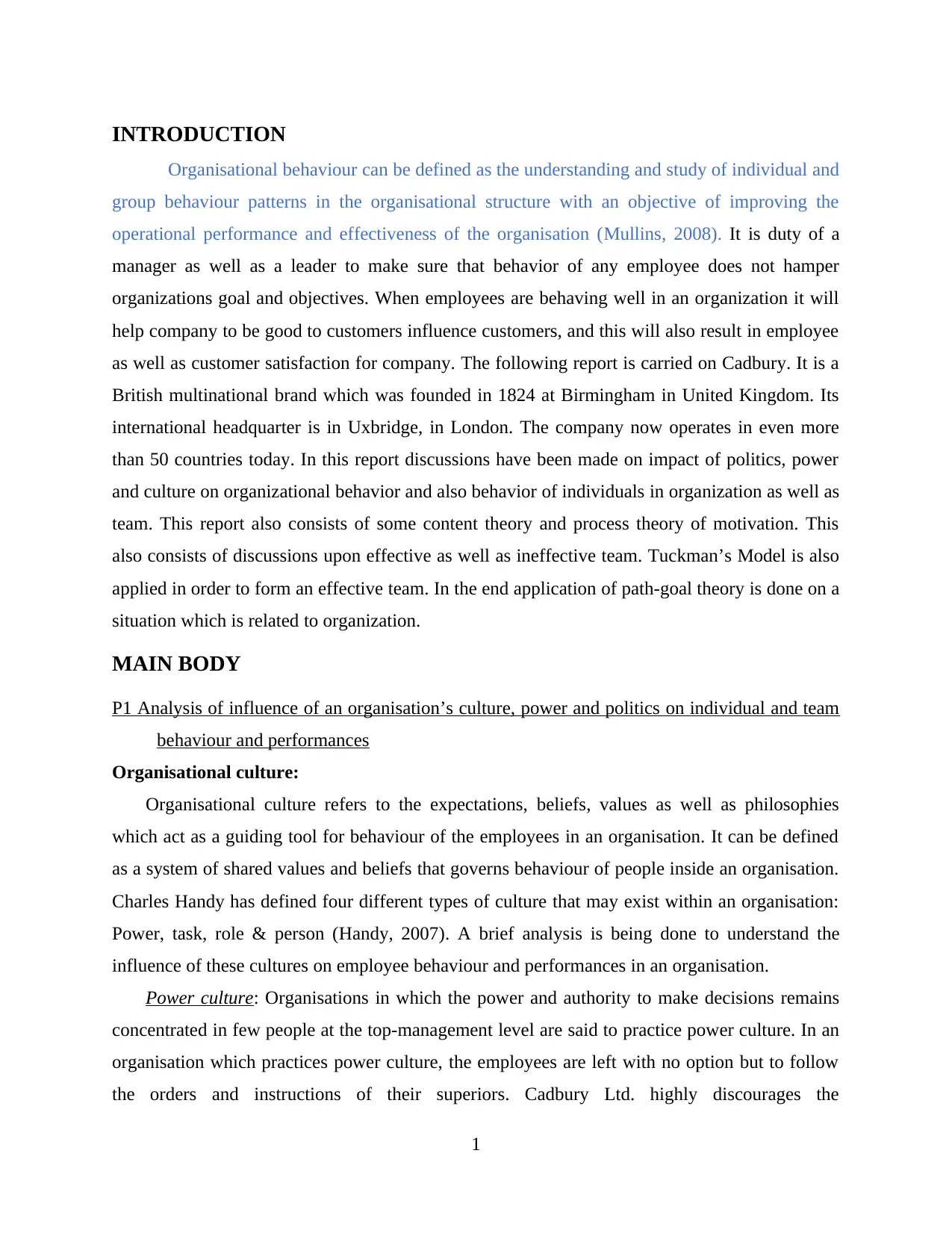
INTRODUCTION
Organisational behaviour can be defined as the understanding and study of individual and
group behaviour patterns in the organisational structure with an objective of improving the
operational performance and effectiveness of the organisation (Mullins, 2008). It is duty of a
manager as well as a leader to make sure that behavior of any employee does not hamper
organizations goal and objectives. When employees are behaving well in an organization it will
help company to be good to customers influence customers, and this will also result in employee
as well as customer satisfaction for company. The following report is carried on Cadbury. It is a
British multinational brand which was founded in 1824 at Birmingham in United Kingdom. Its
international headquarter is in Uxbridge, in London. The company now operates in even more
than 50 countries today. In this report discussions have been made on impact of politics, power
and culture on organizational behavior and also behavior of individuals in organization as well as
team. This report also consists of some content theory and process theory of motivation. This
also consists of discussions upon effective as well as ineffective team. Tuckman’s Model is also
applied in order to form an effective team. In the end application of path-goal theory is done on a
situation which is related to organization.
MAIN BODY
P1 Analysis of influence of an organisation’s culture, power and politics on individual and team
behaviour and performances
Organisational culture:
Organisational culture refers to the expectations, beliefs, values as well as philosophies
which act as a guiding tool for behaviour of the employees in an organisation. It can be defined
as a system of shared values and beliefs that governs behaviour of people inside an organisation.
Charles Handy has defined four different types of culture that may exist within an organisation:
Power, task, role & person (Handy, 2007). A brief analysis is being done to understand the
influence of these cultures on employee behaviour and performances in an organisation.
Power culture: Organisations in which the power and authority to make decisions remains
concentrated in few people at the top-management level are said to practice power culture. In an
organisation which practices power culture, the employees are left with no option but to follow
the orders and instructions of their superiors. Cadbury Ltd. highly discourages the
1
Organisational behaviour can be defined as the understanding and study of individual and
group behaviour patterns in the organisational structure with an objective of improving the
operational performance and effectiveness of the organisation (Mullins, 2008). It is duty of a
manager as well as a leader to make sure that behavior of any employee does not hamper
organizations goal and objectives. When employees are behaving well in an organization it will
help company to be good to customers influence customers, and this will also result in employee
as well as customer satisfaction for company. The following report is carried on Cadbury. It is a
British multinational brand which was founded in 1824 at Birmingham in United Kingdom. Its
international headquarter is in Uxbridge, in London. The company now operates in even more
than 50 countries today. In this report discussions have been made on impact of politics, power
and culture on organizational behavior and also behavior of individuals in organization as well as
team. This report also consists of some content theory and process theory of motivation. This
also consists of discussions upon effective as well as ineffective team. Tuckman’s Model is also
applied in order to form an effective team. In the end application of path-goal theory is done on a
situation which is related to organization.
MAIN BODY
P1 Analysis of influence of an organisation’s culture, power and politics on individual and team
behaviour and performances
Organisational culture:
Organisational culture refers to the expectations, beliefs, values as well as philosophies
which act as a guiding tool for behaviour of the employees in an organisation. It can be defined
as a system of shared values and beliefs that governs behaviour of people inside an organisation.
Charles Handy has defined four different types of culture that may exist within an organisation:
Power, task, role & person (Handy, 2007). A brief analysis is being done to understand the
influence of these cultures on employee behaviour and performances in an organisation.
Power culture: Organisations in which the power and authority to make decisions remains
concentrated in few people at the top-management level are said to practice power culture. In an
organisation which practices power culture, the employees are left with no option but to follow
the orders and instructions of their superiors. Cadbury Ltd. highly discourages the
1
⊘ This is a preview!⊘
Do you want full access?
Subscribe today to unlock all pages.

Trusted by 1+ million students worldwide
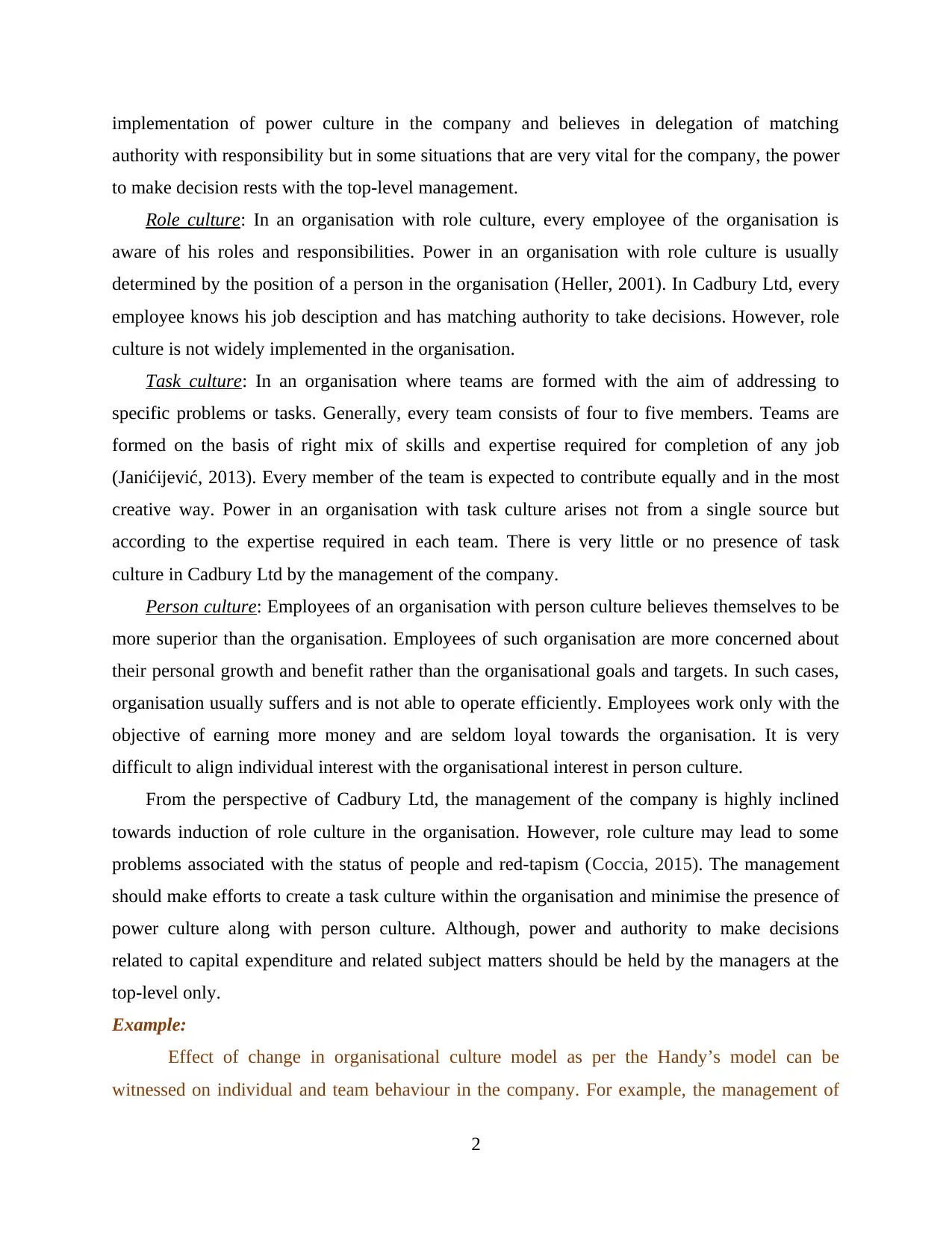
implementation of power culture in the company and believes in delegation of matching
authority with responsibility but in some situations that are very vital for the company, the power
to make decision rests with the top-level management.
Role culture: In an organisation with role culture, every employee of the organisation is
aware of his roles and responsibilities. Power in an organisation with role culture is usually
determined by the position of a person in the organisation (Heller, 2001). In Cadbury Ltd, every
employee knows his job desciption and has matching authority to take decisions. However, role
culture is not widely implemented in the organisation.
Task culture: In an organisation where teams are formed with the aim of addressing to
specific problems or tasks. Generally, every team consists of four to five members. Teams are
formed on the basis of right mix of skills and expertise required for completion of any job
(Janićijević, 2013). Every member of the team is expected to contribute equally and in the most
creative way. Power in an organisation with task culture arises not from a single source but
according to the expertise required in each team. There is very little or no presence of task
culture in Cadbury Ltd by the management of the company.
Person culture: Employees of an organisation with person culture believes themselves to be
more superior than the organisation. Employees of such organisation are more concerned about
their personal growth and benefit rather than the organisational goals and targets. In such cases,
organisation usually suffers and is not able to operate efficiently. Employees work only with the
objective of earning more money and are seldom loyal towards the organisation. It is very
difficult to align individual interest with the organisational interest in person culture.
From the perspective of Cadbury Ltd, the management of the company is highly inclined
towards induction of role culture in the organisation. However, role culture may lead to some
problems associated with the status of people and red-tapism (Coccia, 2015). The management
should make efforts to create a task culture within the organisation and minimise the presence of
power culture along with person culture. Although, power and authority to make decisions
related to capital expenditure and related subject matters should be held by the managers at the
top-level only.
Example:
Effect of change in organisational culture model as per the Handy’s model can be
witnessed on individual and team behaviour in the company. For example, the management of
2
authority with responsibility but in some situations that are very vital for the company, the power
to make decision rests with the top-level management.
Role culture: In an organisation with role culture, every employee of the organisation is
aware of his roles and responsibilities. Power in an organisation with role culture is usually
determined by the position of a person in the organisation (Heller, 2001). In Cadbury Ltd, every
employee knows his job desciption and has matching authority to take decisions. However, role
culture is not widely implemented in the organisation.
Task culture: In an organisation where teams are formed with the aim of addressing to
specific problems or tasks. Generally, every team consists of four to five members. Teams are
formed on the basis of right mix of skills and expertise required for completion of any job
(Janićijević, 2013). Every member of the team is expected to contribute equally and in the most
creative way. Power in an organisation with task culture arises not from a single source but
according to the expertise required in each team. There is very little or no presence of task
culture in Cadbury Ltd by the management of the company.
Person culture: Employees of an organisation with person culture believes themselves to be
more superior than the organisation. Employees of such organisation are more concerned about
their personal growth and benefit rather than the organisational goals and targets. In such cases,
organisation usually suffers and is not able to operate efficiently. Employees work only with the
objective of earning more money and are seldom loyal towards the organisation. It is very
difficult to align individual interest with the organisational interest in person culture.
From the perspective of Cadbury Ltd, the management of the company is highly inclined
towards induction of role culture in the organisation. However, role culture may lead to some
problems associated with the status of people and red-tapism (Coccia, 2015). The management
should make efforts to create a task culture within the organisation and minimise the presence of
power culture along with person culture. Although, power and authority to make decisions
related to capital expenditure and related subject matters should be held by the managers at the
top-level only.
Example:
Effect of change in organisational culture model as per the Handy’s model can be
witnessed on individual and team behaviour in the company. For example, the management of
2
Paraphrase This Document
Need a fresh take? Get an instant paraphrase of this document with our AI Paraphraser
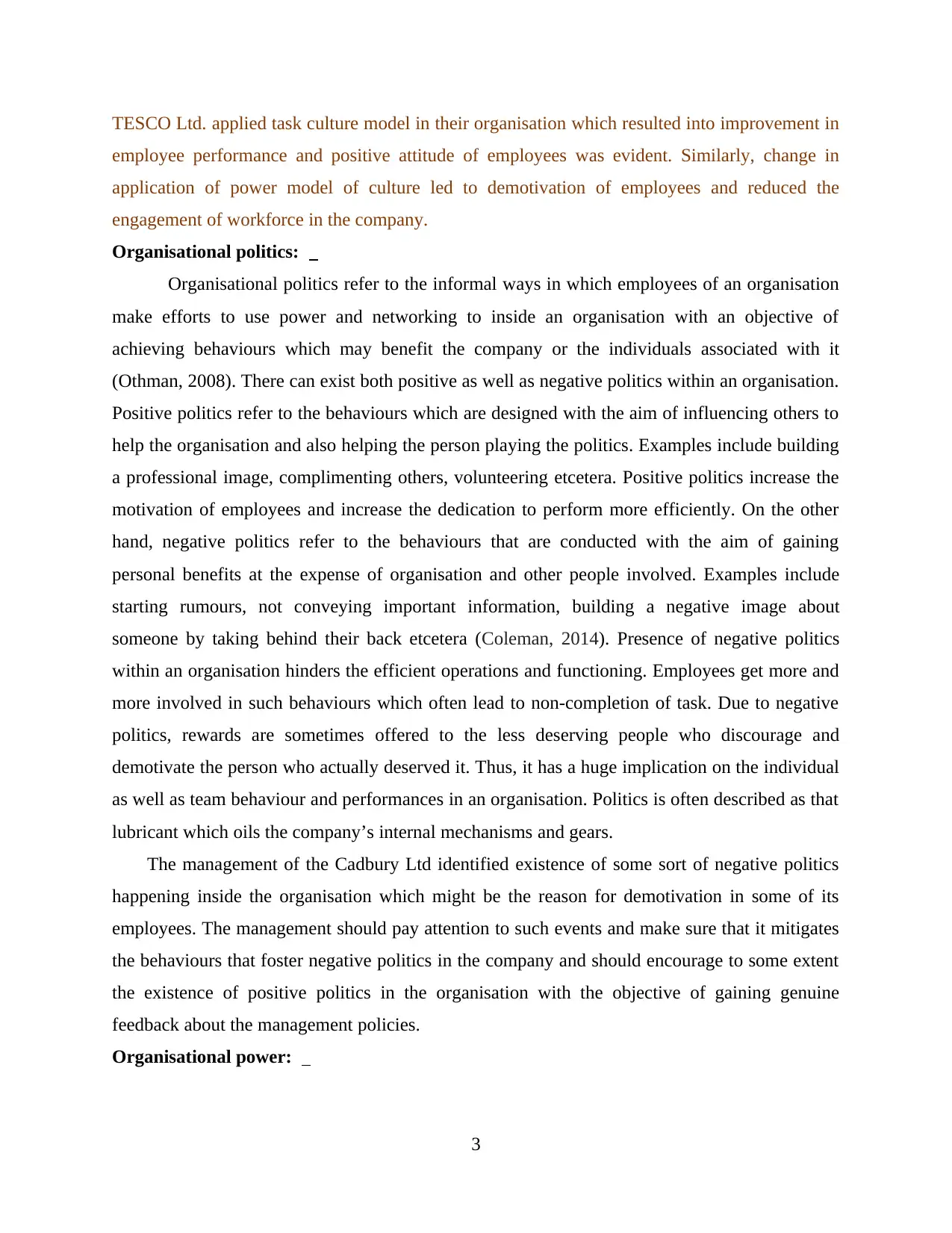
TESCO Ltd. applied task culture model in their organisation which resulted into improvement in
employee performance and positive attitude of employees was evident. Similarly, change in
application of power model of culture led to demotivation of employees and reduced the
engagement of workforce in the company.
Organisational politics:
Organisational politics refer to the informal ways in which employees of an organisation
make efforts to use power and networking to inside an organisation with an objective of
achieving behaviours which may benefit the company or the individuals associated with it
(Othman, 2008). There can exist both positive as well as negative politics within an organisation.
Positive politics refer to the behaviours which are designed with the aim of influencing others to
help the organisation and also helping the person playing the politics. Examples include building
a professional image, complimenting others, volunteering etcetera. Positive politics increase the
motivation of employees and increase the dedication to perform more efficiently. On the other
hand, negative politics refer to the behaviours that are conducted with the aim of gaining
personal benefits at the expense of organisation and other people involved. Examples include
starting rumours, not conveying important information, building a negative image about
someone by taking behind their back etcetera (Coleman, 2014). Presence of negative politics
within an organisation hinders the efficient operations and functioning. Employees get more and
more involved in such behaviours which often lead to non-completion of task. Due to negative
politics, rewards are sometimes offered to the less deserving people who discourage and
demotivate the person who actually deserved it. Thus, it has a huge implication on the individual
as well as team behaviour and performances in an organisation. Politics is often described as that
lubricant which oils the company’s internal mechanisms and gears.
The management of the Cadbury Ltd identified existence of some sort of negative politics
happening inside the organisation which might be the reason for demotivation in some of its
employees. The management should pay attention to such events and make sure that it mitigates
the behaviours that foster negative politics in the company and should encourage to some extent
the existence of positive politics in the organisation with the objective of gaining genuine
feedback about the management policies.
Organisational power:
3
employee performance and positive attitude of employees was evident. Similarly, change in
application of power model of culture led to demotivation of employees and reduced the
engagement of workforce in the company.
Organisational politics:
Organisational politics refer to the informal ways in which employees of an organisation
make efforts to use power and networking to inside an organisation with an objective of
achieving behaviours which may benefit the company or the individuals associated with it
(Othman, 2008). There can exist both positive as well as negative politics within an organisation.
Positive politics refer to the behaviours which are designed with the aim of influencing others to
help the organisation and also helping the person playing the politics. Examples include building
a professional image, complimenting others, volunteering etcetera. Positive politics increase the
motivation of employees and increase the dedication to perform more efficiently. On the other
hand, negative politics refer to the behaviours that are conducted with the aim of gaining
personal benefits at the expense of organisation and other people involved. Examples include
starting rumours, not conveying important information, building a negative image about
someone by taking behind their back etcetera (Coleman, 2014). Presence of negative politics
within an organisation hinders the efficient operations and functioning. Employees get more and
more involved in such behaviours which often lead to non-completion of task. Due to negative
politics, rewards are sometimes offered to the less deserving people who discourage and
demotivate the person who actually deserved it. Thus, it has a huge implication on the individual
as well as team behaviour and performances in an organisation. Politics is often described as that
lubricant which oils the company’s internal mechanisms and gears.
The management of the Cadbury Ltd identified existence of some sort of negative politics
happening inside the organisation which might be the reason for demotivation in some of its
employees. The management should pay attention to such events and make sure that it mitigates
the behaviours that foster negative politics in the company and should encourage to some extent
the existence of positive politics in the organisation with the objective of gaining genuine
feedback about the management policies.
Organisational power:
3
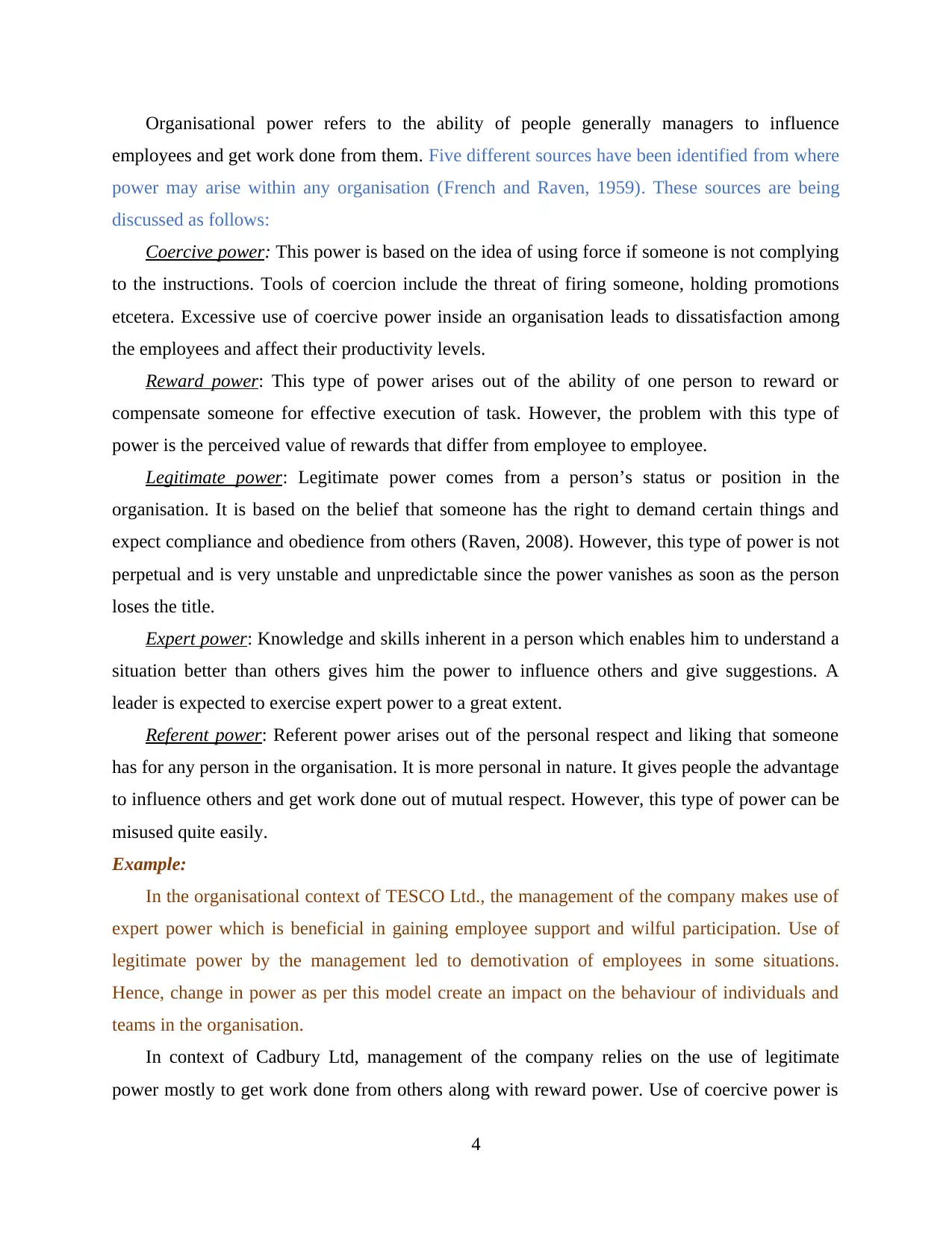
Organisational power refers to the ability of people generally managers to influence
employees and get work done from them. Five different sources have been identified from where
power may arise within any organisation (French and Raven, 1959). These sources are being
discussed as follows:
Coercive power: This power is based on the idea of using force if someone is not complying
to the instructions. Tools of coercion include the threat of firing someone, holding promotions
etcetera. Excessive use of coercive power inside an organisation leads to dissatisfaction among
the employees and affect their productivity levels.
Reward power: This type of power arises out of the ability of one person to reward or
compensate someone for effective execution of task. However, the problem with this type of
power is the perceived value of rewards that differ from employee to employee.
Legitimate power: Legitimate power comes from a person’s status or position in the
organisation. It is based on the belief that someone has the right to demand certain things and
expect compliance and obedience from others (Raven, 2008). However, this type of power is not
perpetual and is very unstable and unpredictable since the power vanishes as soon as the person
loses the title.
Expert power: Knowledge and skills inherent in a person which enables him to understand a
situation better than others gives him the power to influence others and give suggestions. A
leader is expected to exercise expert power to a great extent.
Referent power: Referent power arises out of the personal respect and liking that someone
has for any person in the organisation. It is more personal in nature. It gives people the advantage
to influence others and get work done out of mutual respect. However, this type of power can be
misused quite easily.
Example:
In the organisational context of TESCO Ltd., the management of the company makes use of
expert power which is beneficial in gaining employee support and wilful participation. Use of
legitimate power by the management led to demotivation of employees in some situations.
Hence, change in power as per this model create an impact on the behaviour of individuals and
teams in the organisation.
In context of Cadbury Ltd, management of the company relies on the use of legitimate
power mostly to get work done from others along with reward power. Use of coercive power is
4
employees and get work done from them. Five different sources have been identified from where
power may arise within any organisation (French and Raven, 1959). These sources are being
discussed as follows:
Coercive power: This power is based on the idea of using force if someone is not complying
to the instructions. Tools of coercion include the threat of firing someone, holding promotions
etcetera. Excessive use of coercive power inside an organisation leads to dissatisfaction among
the employees and affect their productivity levels.
Reward power: This type of power arises out of the ability of one person to reward or
compensate someone for effective execution of task. However, the problem with this type of
power is the perceived value of rewards that differ from employee to employee.
Legitimate power: Legitimate power comes from a person’s status or position in the
organisation. It is based on the belief that someone has the right to demand certain things and
expect compliance and obedience from others (Raven, 2008). However, this type of power is not
perpetual and is very unstable and unpredictable since the power vanishes as soon as the person
loses the title.
Expert power: Knowledge and skills inherent in a person which enables him to understand a
situation better than others gives him the power to influence others and give suggestions. A
leader is expected to exercise expert power to a great extent.
Referent power: Referent power arises out of the personal respect and liking that someone
has for any person in the organisation. It is more personal in nature. It gives people the advantage
to influence others and get work done out of mutual respect. However, this type of power can be
misused quite easily.
Example:
In the organisational context of TESCO Ltd., the management of the company makes use of
expert power which is beneficial in gaining employee support and wilful participation. Use of
legitimate power by the management led to demotivation of employees in some situations.
Hence, change in power as per this model create an impact on the behaviour of individuals and
teams in the organisation.
In context of Cadbury Ltd, management of the company relies on the use of legitimate
power mostly to get work done from others along with reward power. Use of coercive power is
4
⊘ This is a preview!⊘
Do you want full access?
Subscribe today to unlock all pages.

Trusted by 1+ million students worldwide
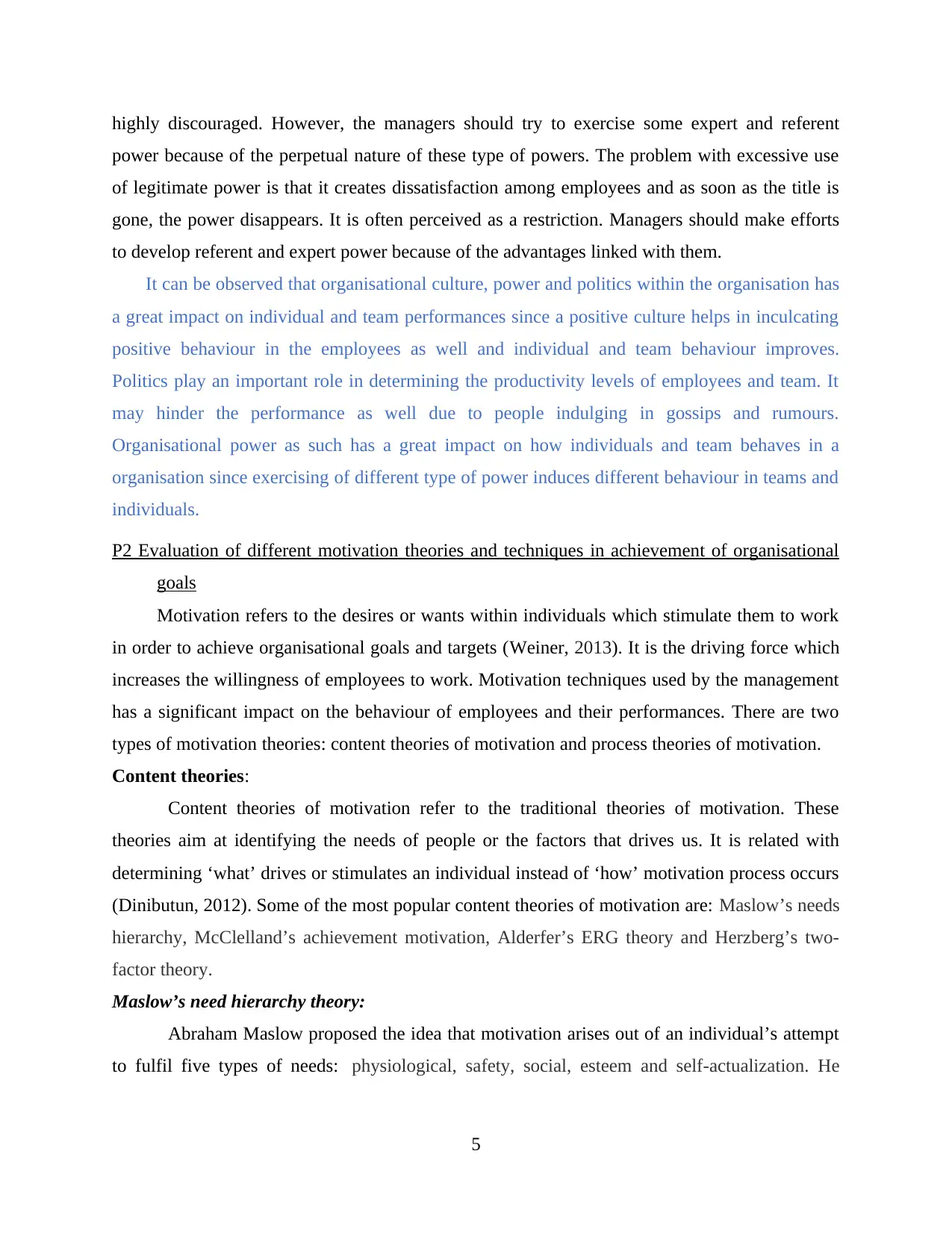
highly discouraged. However, the managers should try to exercise some expert and referent
power because of the perpetual nature of these type of powers. The problem with excessive use
of legitimate power is that it creates dissatisfaction among employees and as soon as the title is
gone, the power disappears. It is often perceived as a restriction. Managers should make efforts
to develop referent and expert power because of the advantages linked with them.
It can be observed that organisational culture, power and politics within the organisation has
a great impact on individual and team performances since a positive culture helps in inculcating
positive behaviour in the employees as well and individual and team behaviour improves.
Politics play an important role in determining the productivity levels of employees and team. It
may hinder the performance as well due to people indulging in gossips and rumours.
Organisational power as such has a great impact on how individuals and team behaves in a
organisation since exercising of different type of power induces different behaviour in teams and
individuals.
P2 Evaluation of different motivation theories and techniques in achievement of organisational
goals
Motivation refers to the desires or wants within individuals which stimulate them to work
in order to achieve organisational goals and targets (Weiner, 2013). It is the driving force which
increases the willingness of employees to work. Motivation techniques used by the management
has a significant impact on the behaviour of employees and their performances. There are two
types of motivation theories: content theories of motivation and process theories of motivation.
Content theories:
Content theories of motivation refer to the traditional theories of motivation. These
theories aim at identifying the needs of people or the factors that drives us. It is related with
determining ‘what’ drives or stimulates an individual instead of ‘how’ motivation process occurs
(Dinibutun, 2012). Some of the most popular content theories of motivation are: Maslow’s needs
hierarchy, McClelland’s achievement motivation, Alderfer’s ERG theory and Herzberg’s two-
factor theory.
Maslow’s need hierarchy theory:
Abraham Maslow proposed the idea that motivation arises out of an individual’s attempt
to fulfil five types of needs: physiological, safety, social, esteem and self-actualization. He
5
power because of the perpetual nature of these type of powers. The problem with excessive use
of legitimate power is that it creates dissatisfaction among employees and as soon as the title is
gone, the power disappears. It is often perceived as a restriction. Managers should make efforts
to develop referent and expert power because of the advantages linked with them.
It can be observed that organisational culture, power and politics within the organisation has
a great impact on individual and team performances since a positive culture helps in inculcating
positive behaviour in the employees as well and individual and team behaviour improves.
Politics play an important role in determining the productivity levels of employees and team. It
may hinder the performance as well due to people indulging in gossips and rumours.
Organisational power as such has a great impact on how individuals and team behaves in a
organisation since exercising of different type of power induces different behaviour in teams and
individuals.
P2 Evaluation of different motivation theories and techniques in achievement of organisational
goals
Motivation refers to the desires or wants within individuals which stimulate them to work
in order to achieve organisational goals and targets (Weiner, 2013). It is the driving force which
increases the willingness of employees to work. Motivation techniques used by the management
has a significant impact on the behaviour of employees and their performances. There are two
types of motivation theories: content theories of motivation and process theories of motivation.
Content theories:
Content theories of motivation refer to the traditional theories of motivation. These
theories aim at identifying the needs of people or the factors that drives us. It is related with
determining ‘what’ drives or stimulates an individual instead of ‘how’ motivation process occurs
(Dinibutun, 2012). Some of the most popular content theories of motivation are: Maslow’s needs
hierarchy, McClelland’s achievement motivation, Alderfer’s ERG theory and Herzberg’s two-
factor theory.
Maslow’s need hierarchy theory:
Abraham Maslow proposed the idea that motivation arises out of an individual’s attempt
to fulfil five types of needs: physiological, safety, social, esteem and self-actualization. He
5
Paraphrase This Document
Need a fresh take? Get an instant paraphrase of this document with our AI Paraphraser
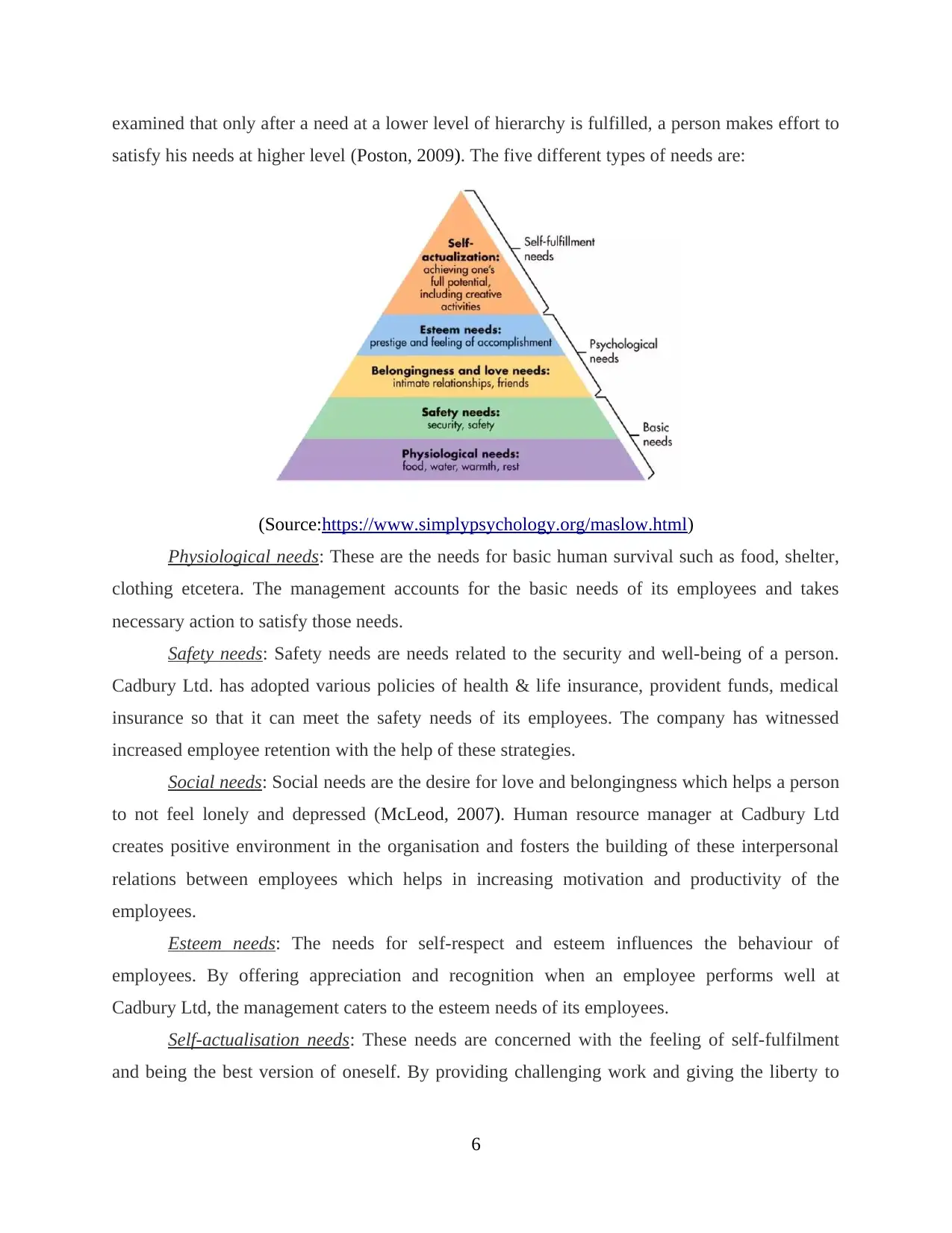
examined that only after a need at a lower level of hierarchy is fulfilled, a person makes effort to
satisfy his needs at higher level (Poston, 2009). The five different types of needs are:
(Source:https://www.simplypsychology.org/maslow.html)
Physiological needs: These are the needs for basic human survival such as food, shelter,
clothing etcetera. The management accounts for the basic needs of its employees and takes
necessary action to satisfy those needs.
Safety needs: Safety needs are needs related to the security and well-being of a person.
Cadbury Ltd. has adopted various policies of health & life insurance, provident funds, medical
insurance so that it can meet the safety needs of its employees. The company has witnessed
increased employee retention with the help of these strategies.
Social needs: Social needs are the desire for love and belongingness which helps a person
to not feel lonely and depressed (McLeod, 2007). Human resource manager at Cadbury Ltd
creates positive environment in the organisation and fosters the building of these interpersonal
relations between employees which helps in increasing motivation and productivity of the
employees.
Esteem needs: The needs for self-respect and esteem influences the behaviour of
employees. By offering appreciation and recognition when an employee performs well at
Cadbury Ltd, the management caters to the esteem needs of its employees.
Self-actualisation needs: These needs are concerned with the feeling of self-fulfilment
and being the best version of oneself. By providing challenging work and giving the liberty to
6
satisfy his needs at higher level (Poston, 2009). The five different types of needs are:
(Source:https://www.simplypsychology.org/maslow.html)
Physiological needs: These are the needs for basic human survival such as food, shelter,
clothing etcetera. The management accounts for the basic needs of its employees and takes
necessary action to satisfy those needs.
Safety needs: Safety needs are needs related to the security and well-being of a person.
Cadbury Ltd. has adopted various policies of health & life insurance, provident funds, medical
insurance so that it can meet the safety needs of its employees. The company has witnessed
increased employee retention with the help of these strategies.
Social needs: Social needs are the desire for love and belongingness which helps a person
to not feel lonely and depressed (McLeod, 2007). Human resource manager at Cadbury Ltd
creates positive environment in the organisation and fosters the building of these interpersonal
relations between employees which helps in increasing motivation and productivity of the
employees.
Esteem needs: The needs for self-respect and esteem influences the behaviour of
employees. By offering appreciation and recognition when an employee performs well at
Cadbury Ltd, the management caters to the esteem needs of its employees.
Self-actualisation needs: These needs are concerned with the feeling of self-fulfilment
and being the best version of oneself. By providing challenging work and giving the liberty to
6
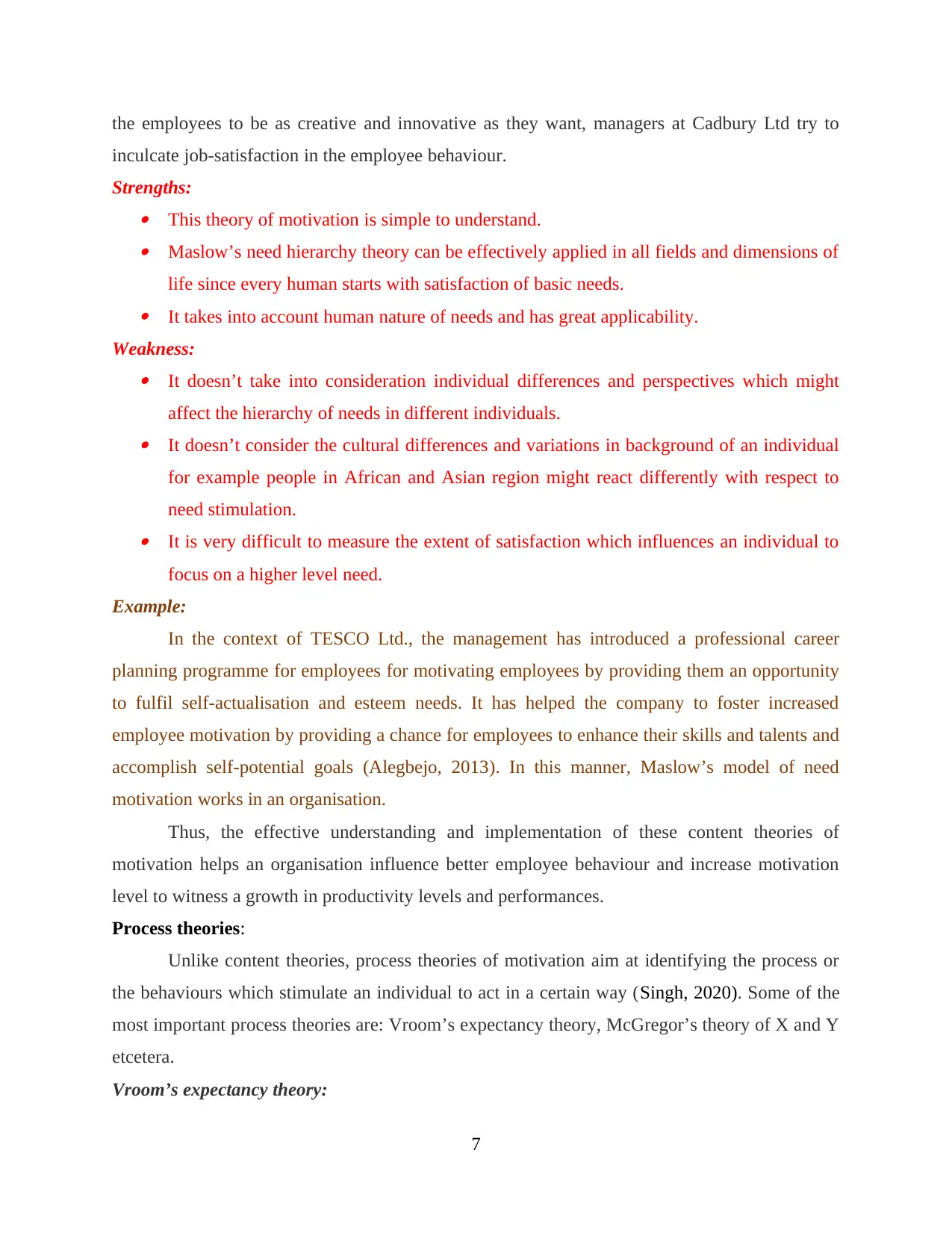
the employees to be as creative and innovative as they want, managers at Cadbury Ltd try to
inculcate job-satisfaction in the employee behaviour.
Strengths: This theory of motivation is simple to understand. Maslow’s need hierarchy theory can be effectively applied in all fields and dimensions of
life since every human starts with satisfaction of basic needs. It takes into account human nature of needs and has great applicability.
Weakness: It doesn’t take into consideration individual differences and perspectives which might
affect the hierarchy of needs in different individuals. It doesn’t consider the cultural differences and variations in background of an individual
for example people in African and Asian region might react differently with respect to
need stimulation. It is very difficult to measure the extent of satisfaction which influences an individual to
focus on a higher level need.
Example:
In the context of TESCO Ltd., the management has introduced a professional career
planning programme for employees for motivating employees by providing them an opportunity
to fulfil self-actualisation and esteem needs. It has helped the company to foster increased
employee motivation by providing a chance for employees to enhance their skills and talents and
accomplish self-potential goals (Alegbejo, 2013). In this manner, Maslow’s model of need
motivation works in an organisation.
Thus, the effective understanding and implementation of these content theories of
motivation helps an organisation influence better employee behaviour and increase motivation
level to witness a growth in productivity levels and performances.
Process theories:
Unlike content theories, process theories of motivation aim at identifying the process or
the behaviours which stimulate an individual to act in a certain way (Singh, 2020). Some of the
most important process theories are: Vroom’s expectancy theory, McGregor’s theory of X and Y
etcetera.
Vroom’s expectancy theory:
7
inculcate job-satisfaction in the employee behaviour.
Strengths: This theory of motivation is simple to understand. Maslow’s need hierarchy theory can be effectively applied in all fields and dimensions of
life since every human starts with satisfaction of basic needs. It takes into account human nature of needs and has great applicability.
Weakness: It doesn’t take into consideration individual differences and perspectives which might
affect the hierarchy of needs in different individuals. It doesn’t consider the cultural differences and variations in background of an individual
for example people in African and Asian region might react differently with respect to
need stimulation. It is very difficult to measure the extent of satisfaction which influences an individual to
focus on a higher level need.
Example:
In the context of TESCO Ltd., the management has introduced a professional career
planning programme for employees for motivating employees by providing them an opportunity
to fulfil self-actualisation and esteem needs. It has helped the company to foster increased
employee motivation by providing a chance for employees to enhance their skills and talents and
accomplish self-potential goals (Alegbejo, 2013). In this manner, Maslow’s model of need
motivation works in an organisation.
Thus, the effective understanding and implementation of these content theories of
motivation helps an organisation influence better employee behaviour and increase motivation
level to witness a growth in productivity levels and performances.
Process theories:
Unlike content theories, process theories of motivation aim at identifying the process or
the behaviours which stimulate an individual to act in a certain way (Singh, 2020). Some of the
most important process theories are: Vroom’s expectancy theory, McGregor’s theory of X and Y
etcetera.
Vroom’s expectancy theory:
7
⊘ This is a preview!⊘
Do you want full access?
Subscribe today to unlock all pages.

Trusted by 1+ million students worldwide
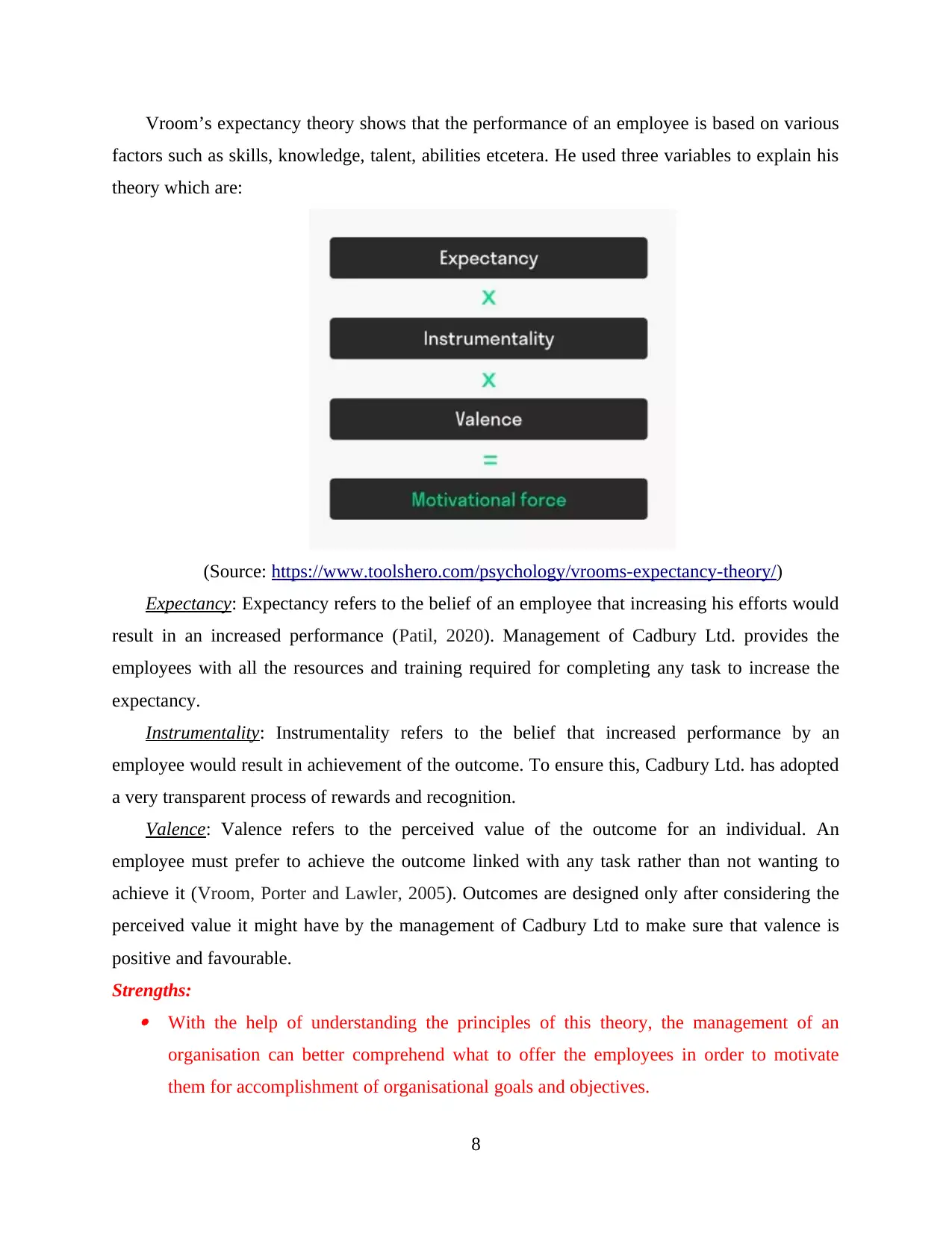
Vroom’s expectancy theory shows that the performance of an employee is based on various
factors such as skills, knowledge, talent, abilities etcetera. He used three variables to explain his
theory which are:
(Source: https://www.toolshero.com/psychology/vrooms-expectancy-theory/)
Expectancy: Expectancy refers to the belief of an employee that increasing his efforts would
result in an increased performance (Patil, 2020). Management of Cadbury Ltd. provides the
employees with all the resources and training required for completing any task to increase the
expectancy.
Instrumentality: Instrumentality refers to the belief that increased performance by an
employee would result in achievement of the outcome. To ensure this, Cadbury Ltd. has adopted
a very transparent process of rewards and recognition.
Valence: Valence refers to the perceived value of the outcome for an individual. An
employee must prefer to achieve the outcome linked with any task rather than not wanting to
achieve it (Vroom, Porter and Lawler, 2005). Outcomes are designed only after considering the
perceived value it might have by the management of Cadbury Ltd to make sure that valence is
positive and favourable.
Strengths: With the help of understanding the principles of this theory, the management of an
organisation can better comprehend what to offer the employees in order to motivate
them for accomplishment of organisational goals and objectives.
8
factors such as skills, knowledge, talent, abilities etcetera. He used three variables to explain his
theory which are:
(Source: https://www.toolshero.com/psychology/vrooms-expectancy-theory/)
Expectancy: Expectancy refers to the belief of an employee that increasing his efforts would
result in an increased performance (Patil, 2020). Management of Cadbury Ltd. provides the
employees with all the resources and training required for completing any task to increase the
expectancy.
Instrumentality: Instrumentality refers to the belief that increased performance by an
employee would result in achievement of the outcome. To ensure this, Cadbury Ltd. has adopted
a very transparent process of rewards and recognition.
Valence: Valence refers to the perceived value of the outcome for an individual. An
employee must prefer to achieve the outcome linked with any task rather than not wanting to
achieve it (Vroom, Porter and Lawler, 2005). Outcomes are designed only after considering the
perceived value it might have by the management of Cadbury Ltd to make sure that valence is
positive and favourable.
Strengths: With the help of understanding the principles of this theory, the management of an
organisation can better comprehend what to offer the employees in order to motivate
them for accomplishment of organisational goals and objectives.
8
Paraphrase This Document
Need a fresh take? Get an instant paraphrase of this document with our AI Paraphraser
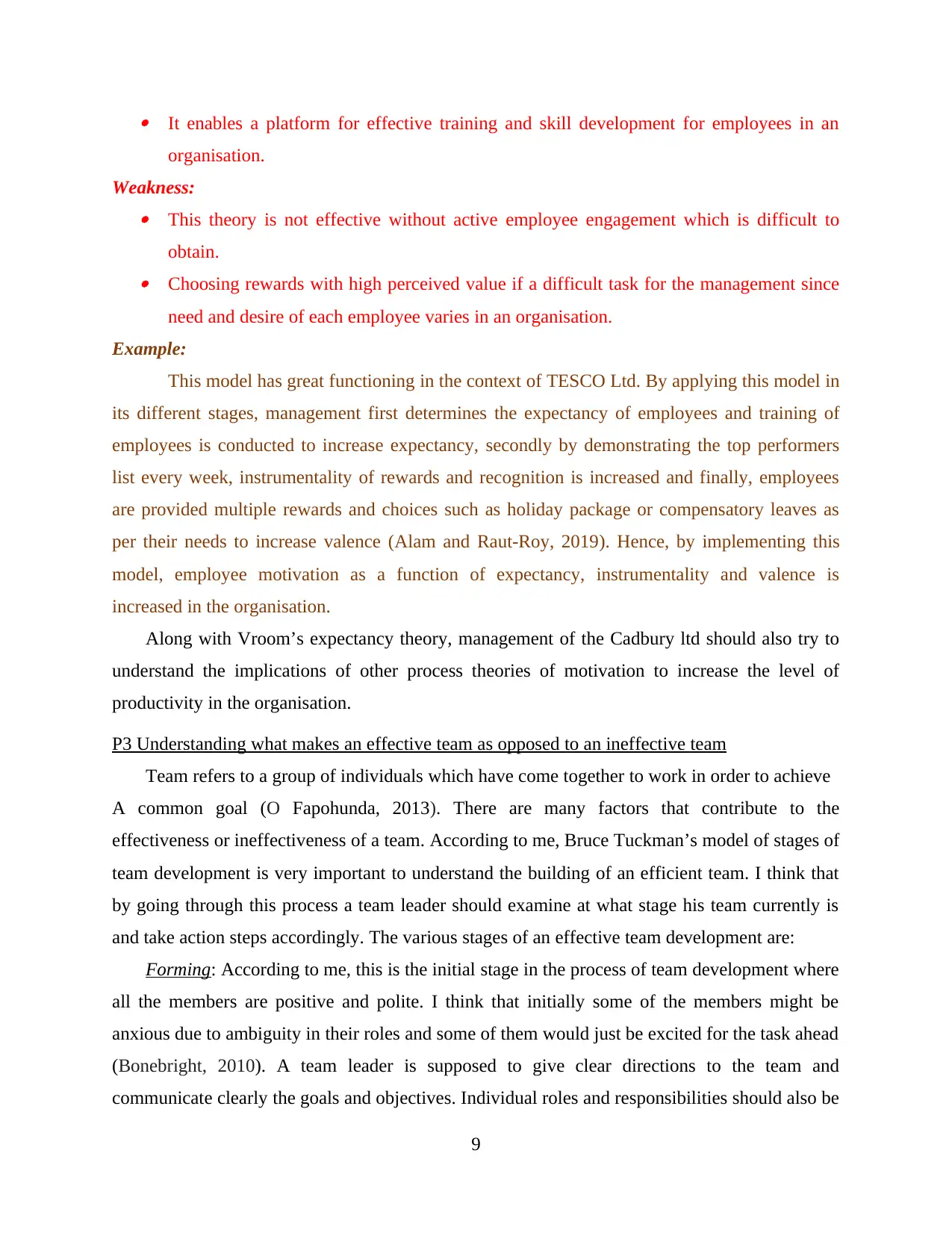
It enables a platform for effective training and skill development for employees in an
organisation.
Weakness: This theory is not effective without active employee engagement which is difficult to
obtain. Choosing rewards with high perceived value if a difficult task for the management since
need and desire of each employee varies in an organisation.
Example:
This model has great functioning in the context of TESCO Ltd. By applying this model in
its different stages, management first determines the expectancy of employees and training of
employees is conducted to increase expectancy, secondly by demonstrating the top performers
list every week, instrumentality of rewards and recognition is increased and finally, employees
are provided multiple rewards and choices such as holiday package or compensatory leaves as
per their needs to increase valence (Alam and Raut-Roy, 2019). Hence, by implementing this
model, employee motivation as a function of expectancy, instrumentality and valence is
increased in the organisation.
Along with Vroom’s expectancy theory, management of the Cadbury ltd should also try to
understand the implications of other process theories of motivation to increase the level of
productivity in the organisation.
P3 Understanding what makes an effective team as opposed to an ineffective team
Team refers to a group of individuals which have come together to work in order to achieve
A common goal (O Fapohunda, 2013). There are many factors that contribute to the
effectiveness or ineffectiveness of a team. According to me, Bruce Tuckman’s model of stages of
team development is very important to understand the building of an efficient team. I think that
by going through this process a team leader should examine at what stage his team currently is
and take action steps accordingly. The various stages of an effective team development are:
Forming: According to me, this is the initial stage in the process of team development where
all the members are positive and polite. I think that initially some of the members might be
anxious due to ambiguity in their roles and some of them would just be excited for the task ahead
(Bonebright, 2010). A team leader is supposed to give clear directions to the team and
communicate clearly the goals and objectives. Individual roles and responsibilities should also be
9
organisation.
Weakness: This theory is not effective without active employee engagement which is difficult to
obtain. Choosing rewards with high perceived value if a difficult task for the management since
need and desire of each employee varies in an organisation.
Example:
This model has great functioning in the context of TESCO Ltd. By applying this model in
its different stages, management first determines the expectancy of employees and training of
employees is conducted to increase expectancy, secondly by demonstrating the top performers
list every week, instrumentality of rewards and recognition is increased and finally, employees
are provided multiple rewards and choices such as holiday package or compensatory leaves as
per their needs to increase valence (Alam and Raut-Roy, 2019). Hence, by implementing this
model, employee motivation as a function of expectancy, instrumentality and valence is
increased in the organisation.
Along with Vroom’s expectancy theory, management of the Cadbury ltd should also try to
understand the implications of other process theories of motivation to increase the level of
productivity in the organisation.
P3 Understanding what makes an effective team as opposed to an ineffective team
Team refers to a group of individuals which have come together to work in order to achieve
A common goal (O Fapohunda, 2013). There are many factors that contribute to the
effectiveness or ineffectiveness of a team. According to me, Bruce Tuckman’s model of stages of
team development is very important to understand the building of an efficient team. I think that
by going through this process a team leader should examine at what stage his team currently is
and take action steps accordingly. The various stages of an effective team development are:
Forming: According to me, this is the initial stage in the process of team development where
all the members are positive and polite. I think that initially some of the members might be
anxious due to ambiguity in their roles and some of them would just be excited for the task ahead
(Bonebright, 2010). A team leader is supposed to give clear directions to the team and
communicate clearly the goals and objectives. Individual roles and responsibilities should also be
9
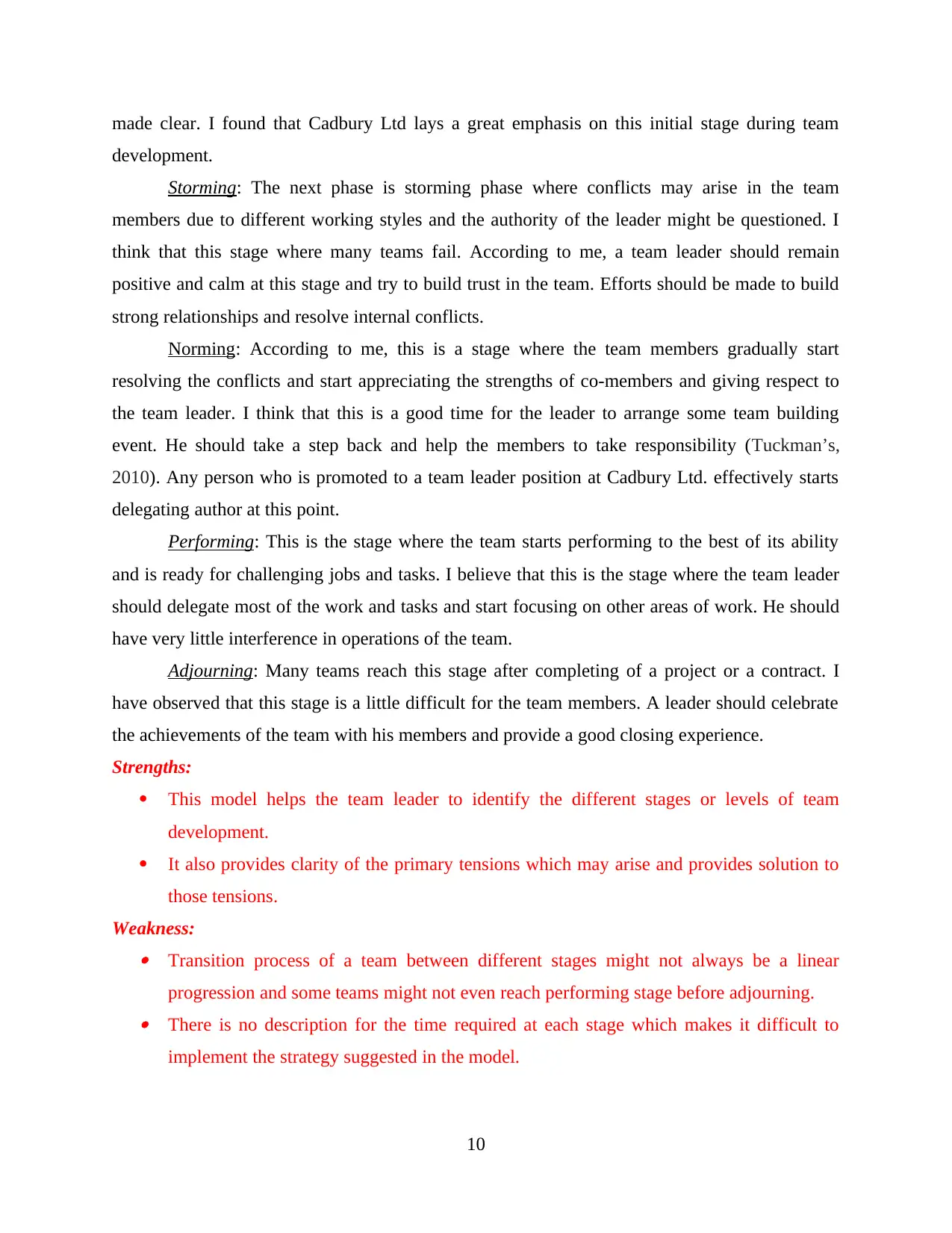
made clear. I found that Cadbury Ltd lays a great emphasis on this initial stage during team
development.
Storming: The next phase is storming phase where conflicts may arise in the team
members due to different working styles and the authority of the leader might be questioned. I
think that this stage where many teams fail. According to me, a team leader should remain
positive and calm at this stage and try to build trust in the team. Efforts should be made to build
strong relationships and resolve internal conflicts.
Norming: According to me, this is a stage where the team members gradually start
resolving the conflicts and start appreciating the strengths of co-members and giving respect to
the team leader. I think that this is a good time for the leader to arrange some team building
event. He should take a step back and help the members to take responsibility (Tuckman’s,
2010). Any person who is promoted to a team leader position at Cadbury Ltd. effectively starts
delegating author at this point.
Performing: This is the stage where the team starts performing to the best of its ability
and is ready for challenging jobs and tasks. I believe that this is the stage where the team leader
should delegate most of the work and tasks and start focusing on other areas of work. He should
have very little interference in operations of the team.
Adjourning: Many teams reach this stage after completing of a project or a contract. I
have observed that this stage is a little difficult for the team members. A leader should celebrate
the achievements of the team with his members and provide a good closing experience.
Strengths:
This model helps the team leader to identify the different stages or levels of team
development.
It also provides clarity of the primary tensions which may arise and provides solution to
those tensions.
Weakness: Transition process of a team between different stages might not always be a linear
progression and some teams might not even reach performing stage before adjourning. There is no description for the time required at each stage which makes it difficult to
implement the strategy suggested in the model.
10
development.
Storming: The next phase is storming phase where conflicts may arise in the team
members due to different working styles and the authority of the leader might be questioned. I
think that this stage where many teams fail. According to me, a team leader should remain
positive and calm at this stage and try to build trust in the team. Efforts should be made to build
strong relationships and resolve internal conflicts.
Norming: According to me, this is a stage where the team members gradually start
resolving the conflicts and start appreciating the strengths of co-members and giving respect to
the team leader. I think that this is a good time for the leader to arrange some team building
event. He should take a step back and help the members to take responsibility (Tuckman’s,
2010). Any person who is promoted to a team leader position at Cadbury Ltd. effectively starts
delegating author at this point.
Performing: This is the stage where the team starts performing to the best of its ability
and is ready for challenging jobs and tasks. I believe that this is the stage where the team leader
should delegate most of the work and tasks and start focusing on other areas of work. He should
have very little interference in operations of the team.
Adjourning: Many teams reach this stage after completing of a project or a contract. I
have observed that this stage is a little difficult for the team members. A leader should celebrate
the achievements of the team with his members and provide a good closing experience.
Strengths:
This model helps the team leader to identify the different stages or levels of team
development.
It also provides clarity of the primary tensions which may arise and provides solution to
those tensions.
Weakness: Transition process of a team between different stages might not always be a linear
progression and some teams might not even reach performing stage before adjourning. There is no description for the time required at each stage which makes it difficult to
implement the strategy suggested in the model.
10
⊘ This is a preview!⊘
Do you want full access?
Subscribe today to unlock all pages.

Trusted by 1+ million students worldwide
1 out of 18
Related Documents
Your All-in-One AI-Powered Toolkit for Academic Success.
+13062052269
info@desklib.com
Available 24*7 on WhatsApp / Email
![[object Object]](/_next/static/media/star-bottom.7253800d.svg)
Unlock your academic potential
Copyright © 2020–2025 A2Z Services. All Rights Reserved. Developed and managed by ZUCOL.





